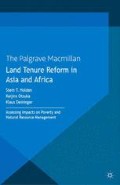Abstract
Land reform in countries with high levels of land inequality is seen by most development experts as an effective means of reducing poverty, since land enriches the asset portfolio of poor households (HHs) and carries with it the potential for agricultural production and entrepreneurship. The objectives of land redistribution are largely classified into (i) social, (ii) economic (iii) political and (iv) environmental. As expressed by Binswanger et al. (2009), advocates of social land reform expect little overall economic gain from the reform, but see it as a way to provide some security and subsistence to a large unemployed rural labor force. To them, the main thrust of agricultural development is to come from large-scale farms and the supporting agro-industrial sectors. The advocates of economic land reform stress the productive superiority of family farms; and they expect the land reform to make a significant contribution not only to agricultural production, but also to rural employment, self-employment, and poverty reduction. The arguments in favor of economic land reform presented above are also consistent with the economic theory which states that a one-time egalitarian distribution of assets in an environment of imperfect markets is associated with permanent higher levels of growth (Deininger et al., 1999). Consistent with this notion, Aghion et al. (1999) express the fact that redistribution in an economy can be conducive to growth. Furthermore, cross-country regressions (Birdsall and Londono, 1998; World Bank, 2001) also provide evidence that greater inequality in the distribution of assets such as land is associated with lower subsequent growth.
Access this chapter
Tax calculation will be finalised at checkout
Purchases are for personal use only
Preview
Unable to display preview. Download preview PDF.
References
Aghion, P., Caroli, E. and Garcia-Penalosa, C. (1999) ‘Inequality and Economic Growth: The Perspective of the New Growth Theories’, Journal of Economic Literature.
Binswanger-Mkhize, H., Bourguignon, C. and van den Brink, R. (2009) ‘Agricultural Land Redistribution: Towards Greater Consensus’, Washington DC, The World Bank.
Birdsall, N. and Londono, J.L. (1998) ‘No Tradeoff: Efficient Growth Via More Equal Human Capital in Latin America’, in N. Birdsall, C. Graham, and R. Sabot (eds), Beyond tradeoffs: Market Reforms and Equitable Growth in Latin America (Washington, D.C.: Brookings Institution Press and Inter-American Development Bank).
Blundell, R. and Costa Dias, M. (2000) ‘Evaluation Methods for Non-Experimental Data’, Fiscal Studies 21(4), 427–68.
Caliendo, M. and Kopeinig, S. (2008) ‘Some Practical Guidance for the Implementation of Propensity Score Matching’, Journal of Economic Surveys, 22, 31–72. doi: 10.1111/j.1467–6419.2007.00527.
Chirwa, E.W. (2004) ‘Access to Land, Growth and Poverty Reduction in Malawi’, Report submitted to the North-South Institute, Canada.
Chirwa, E.W. and Chinsinga (2008) ‘The Economics and Politics of Land Reform in Malawi: A Case Study of the Community Based Rural Land Development Program’, IPPG Paper briefing No. 18.
Deininger, K., Lara, R, Olinto, P. and Maertens, M. (1999) ‘Redistribution, Investment and Human Capital Accumulation: The Case of Agrarian Reform in the Philippines’, Working Paper, World Bank
de Janvry, A. and Sadoulet, E. (2001) ‘Rural Poverty and Effective Rural Development Strategies’, in H. Clemens and R. Ruben (eds), Nueva Ruralidad y Politica Agraria. Caracas (Venezuela: Editorial Nueva Sociedad).
Government of the Republic of Malawi (2002) ‘Malawi National Land Policy’, Government of the Republic of Malawi, Lilongwe.
Government of the Republic of Malawi (2008) ‘Malawi Population and Housing Census’, National statistical office, Malawi.
Heckman, James, R. Lai onde, and Smith, J. (1999) ‘The Economics and Econometrics of Active Labor Market Programs’, Handbook of Labor Economics, Volume 3, Ashenfelter, A. and D.
Holden, S., Kaarhus, R. and Lunduka, R. (2006) ‘Land Policy Reform: The Role of Land Markets and Women’s Land Rights in Malawi’, Noragric Report No. 36 (October), Department of International Environment and Development Studies, Noragric, Norwegian University of Life Sciences (UMB), Norway.
Imbens, G.W. and Angrist, J.D. (1994) ‘Identification and Estimation of Local Average Treatment Effects’, Econometrica, 62, 467–76.
Lele, U. (1989) ‘Sources of Growth in East African Agriculture’, World Bank Economic Review, 3, 119–44.
Machira S. (2008) ‘Riot-Testing a Land Redistribution Program in Malawi’, in H.P. Binswanger, C. Bourguignon and R. van den Brink (eds), Agricultural Land edistribution: Towards Greater Consensus, The World Bank.
Robilliard, A.S., Sukume, C, Yanoma, Y. and Löfgren, H. (2002) ‘Land Reform in Zimbabwe: Farm-level Effects and Cost-Benefit Analysis’, Review report, World Bank Lilongwe.
Rosenzweig, M.R. and Binswanger, H.R (1993) ‘Wealth, Weather risk and the Composition and Profitability of Agricultural Investments’, Economic Journal, 103, 56–78.
Saidi, Patrick M. (1999) Final Report of the Presidential Commission of Inquiry on Land Policy Reform, Malawi Government, Lilongwe.
Simtowe, R, Magisoni, J. and Mendola, M. (2011) ‘Independent Project Impact Evaluation of the Community Based Rural Land Development in Malawi’, Contract Nr. 013/IPC/CB/09/10.
Takane, Tsutomu (2007) ‘Gambling with Liberalization: Smallholder Livelihoods in Contemporary Rural Malawi’, Institute of Developing Economies Working Paper, JETRO.
Wooldridge, J.M. (2001) ‘Instrumental Estimation of the Average Treatment Effect in the Correlated Random Coefficient Model’, Department of Economics, Michigan State University, Michigan.
World Bank (2001) World Development Report 2000/2001: Attacking Poverty (New York: Oxford University Press).
World Bank (2007) An Economic Analysis of the Malawi Land Project-A Mid Term.
Author information
Authors and Affiliations
Editor information
Editors and Affiliations
Copyright information
© 2013 Franklin Simtowe, Mariapia Mendola, Julius Mangisoni, Hardwick Tchale and Clement Nyirongo
About this chapter
Cite this chapter
Simtowe, F., Mendola, M., Mangisoni, J., Tchale, H., Nyirongo, C. (2013). The Economic Effects of Land Redistribution: The Case of a Community-Based Rural Land Development Project in Malawi. In: Holden, S.T., Otsuka, K., Deininger, K. (eds) Land Tenure Reform in Asia and Africa. Palgrave Macmillan, London. https://doi.org/10.1057/9781137343819_5
Download citation
DOI: https://doi.org/10.1057/9781137343819_5
Publisher Name: Palgrave Macmillan, London
Print ISBN: 978-1-349-46586-6
Online ISBN: 978-1-137-34381-9
eBook Packages: Palgrave Economics & Finance CollectionEconomics and Finance (R0)

